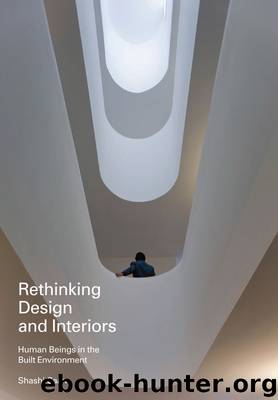Rethinking Design and Interiors by Caan Shashi;

Author:Caan, Shashi;
Language: eng
Format: epub
Publisher: Laurence King Publishing
Volumetric studies by students of Rowena Reed Kostellow. The integral first layer of design knowledge is the creation of the skills of visual literacy. One of the most compelling models is Reed’s method, as taught for decades at Pratt Institute in New York. Reed had students create repeated three-dimensional exercises, so that they would be able to envision three-dimensional space mentally through the constant manipulation of these forms. As with any other learnt art, practice (in this case of looking, seeing, and assessing) makes for a better inherent literacy and knowledge. The ability to visually compare and contrast is an important component for learning visual literacy.
John Chris Jones acknowledges the complex nature of design in his 1992 Design Methods, which often serves as a basic textbook:
[D]esigning should not be confused with art, with science, or with mathematics. It is a hybrid activity which depends, for its successful execution, upon a proper blending of all three and is most unlikely to succeed if it is exclusively identified with any one. The main point of difference is that of timing. Both artists and scientists operate on the physical world as it exists in the present (whether it is real or symbolic), while mathematicians operate on abstract relationships that are independent of historical time. Designers, on the other hand, are forever bound to treat as real that which exists only in an imagined future and have to specify ways in which the foreseen thing can be made to exist.20
This is the crux of the matter: the task of design is not limited to the creation of a few incidental or stand-alone objects. It is a comprehensive means of shaping the future of the entire built environment and every human interaction that takes place within it.
Design, which is inherently concerned with progress, must maintain step with the technological and scientific influences that shape the world. In an era when the duplication of man itself is scientifically possible, the designer is charged with helping us to understand the impacts of these and other advances, and finding appropriate and imaginative responses that support individuals and society at large.
In 1967 James Marston Fitch, a prominent educator and journalist who wrote about architecture and design, had argued that the designer of the built environment was more similar “to the artist than to the scientist” since, like the former, the designer “aspires to the creation of formal order.”21 The creation of a building or any designed space was, for Fitch, a rigorous and structured exercise that sought “to resolve the contradictions between form and content in such a way as to extract from it a work of high esthetic value.”22 In this model, a building must begin with an artistic goal but can be considered successfully complete only if its function is fully resolved. Fitch elaborated: though design for the built environment must “be susceptible of manipulation for purely formal ends, the content of [the designer’s] work is wholly different: social process and live human beings, each with ineluctably non-aesthetic requirements .
Download
This site does not store any files on its server. We only index and link to content provided by other sites. Please contact the content providers to delete copyright contents if any and email us, we'll remove relevant links or contents immediately.
Kathy Andrews Collection by Kathy Andrews(11730)
The remains of the day by Kazuo Ishiguro(8821)
Paper Towns by Green John(5089)
Spare by Prince Harry The Duke of Sussex(5072)
Industrial Automation from Scratch: A hands-on guide to using sensors, actuators, PLCs, HMIs, and SCADA to automate industrial processes by Olushola Akande(4979)
The Body: A Guide for Occupants by Bill Bryson(4974)
Machine Learning at Scale with H2O by Gregory Keys | David Whiting(4179)
Be in a Treehouse by Pete Nelson(3947)
Never by Ken Follett(3790)
Harry Potter and the Goblet Of Fire by J.K. Rowling(3774)
Goodbye Paradise(3727)
Into Thin Air by Jon Krakauer(3312)
The Remains of the Day by Kazuo Ishiguro(3293)
The Cellar by Natasha Preston(3261)
The Genius of Japanese Carpentry by Azby Brown(3224)
Fairy Tale by Stephen King(3220)
120 Days of Sodom by Marquis de Sade(3180)
The Man Who Died Twice by Richard Osman(2997)
Drawing Shortcuts: Developing Quick Drawing Skills Using Today's Technology by Leggitt Jim(2996)
